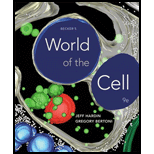
Concept explainers
A New Biofuel. As a recent cell biology graduate, you have just been hired by a
(a) Determining which genes and enzymes are required to produce the oil.
(b) Producing large amounts of a certain enzyme for further research.
(c) Studying whether any of the cellular enzymes interact with each other.
(d) Examining the involvement of any cellular organelles in storage or secretion of the oil.
Want to see the full answer?
Check out a sample textbook solution
Chapter 1 Solutions
Becker's World of the Cell (9th Edition)
Additional Science Textbook Solutions
Microbiology: Principles and Explorations
Genetics: Analysis and Principles
Human Physiology: An Integrated Approach (8th Edition)
Seeley's Anatomy & Physiology
Campbell Biology in Focus
LooseLeaf for Integrated Principles of Zoology
- Please help me with this problemarrow_forwardI. Active site analysis. Below is a diagram of a putative active site for Monoamine oxidase. As we learned, the purpose of tertiary structure is to form a scaffold so you can orient just a few amino acids in the right orientation to promote binding and/or catalysis. The position where this occurs is the active site. The amino acid architecture of an active site is designed to bind substrates. Amino acid side chains are capable of hydrogen bonding, ionic and hydrophobic interactions. Fill in each amino acid that you think is suitable for interacting with the part of the substrate it is closest to. Assume the pH will be at 7.0 a.a.#1 a.a.#2 a.a.#6 HO Lond NH₂ НО a.a.#5 OH a.a.#3 a.a.#4arrow_forwardExplain well. Asaparrow_forward
- I'm a genetic engineering. I want to create a new GMO that benefit curren society. I want to extract the blood from horseshoe crab to the spinach leaves. I found one article that said spinach leaves can grow human tissue. So, I assume that I put the horseshoe crab blood to the spinach leaves can grow animal protein (coagulogen). Then, we use the coagulogen to produce medicine. Provide me detail steps on how to create this GMO.arrow_forwardNeed help, please.arrow_forwardPlease , Explain.arrow_forward
- In Multi-Column Purification of rGFP. What happens to the protein amount, protein purity, and/or specific activity of a purification fraction if one of the three is changed? (i.e. understand the relationship between the three.)arrow_forwardEnzyme Investigation An enzyme was isolated from digestive juices taken from the small intestine. An experiment was set up to test the ability of the enzyme to break down protein. Two test tubes, labeled A and B, were placed in a hot water bath at 37°C, human body temperature. Test tube A contained only protein and test tube B contained protein and the enzyme. The chart below shows the set-up. After two hours, the contents of both test tubes were analyzed. Test tube A showed only the presence of protein. Test tube B showed the presence of the end products of protein digestion, indicating the enzyme had successfully broken down the protein. Identify the end products of protein digestion that made up the contents of test tube B after the two hours.arrow_forwardHow do 3D model structure of transferase enzyme works? Give me a precise and accurate explanation. Thank you!arrow_forward
- Compare and contrast the following. Use your own words and be sure to incorporate key biochemical concepts from the semester. Diagrams are always welcome. A. Peptide vs. steroid hormones (mode of action is key here) B. Brown vs. white adipose tissue C. Fast vs. slow twitch musclearrow_forwardbiochemistry question, please show all work! As the result of a storm while on a three-hour boat tour, you have found yourself on an uncharted island with several other people. The (additional) bad news is that you and your fellow castaways have become infected with a previously unknown, lethally pathogenic organism, P. Fortunately, however, you have discovered a biochemistry laboratory on the island, and you begin to study the organism. In Organism P, the ATP synthase enzyme complex can synthesize ATP using a proton gradient, and can use ATP hydrolysis to generate a proton gradient. For Organism P you measure: pHinside = 8.5, pHoutside = 7.3, and membrane potential = –110 mV.a. Assumingthatthebacteriumisaspherewithadiameterof2.34μm,howmany “free protons” are present in the cell?b. Assuming [ATP] = 5 mM, [ADP] = 1 mM, and [Pi] = 2 mM, and the cellular temperature is 25°C, what is the minimum number of protons that must enter the cell to yield enough energy to synthesize an ATP from an…arrow_forwardplease explain. I will rate your response based on the accuracy of your answers. Two right answers get a thumbs up rating! Thank you.arrow_forward
 Human Anatomy & Physiology (11th Edition)BiologyISBN:9780134580999Author:Elaine N. Marieb, Katja N. HoehnPublisher:PEARSON
Human Anatomy & Physiology (11th Edition)BiologyISBN:9780134580999Author:Elaine N. Marieb, Katja N. HoehnPublisher:PEARSON Biology 2eBiologyISBN:9781947172517Author:Matthew Douglas, Jung Choi, Mary Ann ClarkPublisher:OpenStax
Biology 2eBiologyISBN:9781947172517Author:Matthew Douglas, Jung Choi, Mary Ann ClarkPublisher:OpenStax Anatomy & PhysiologyBiologyISBN:9781259398629Author:McKinley, Michael P., O'loughlin, Valerie Dean, Bidle, Theresa StouterPublisher:Mcgraw Hill Education,
Anatomy & PhysiologyBiologyISBN:9781259398629Author:McKinley, Michael P., O'loughlin, Valerie Dean, Bidle, Theresa StouterPublisher:Mcgraw Hill Education, Molecular Biology of the Cell (Sixth Edition)BiologyISBN:9780815344322Author:Bruce Alberts, Alexander D. Johnson, Julian Lewis, David Morgan, Martin Raff, Keith Roberts, Peter WalterPublisher:W. W. Norton & Company
Molecular Biology of the Cell (Sixth Edition)BiologyISBN:9780815344322Author:Bruce Alberts, Alexander D. Johnson, Julian Lewis, David Morgan, Martin Raff, Keith Roberts, Peter WalterPublisher:W. W. Norton & Company Laboratory Manual For Human Anatomy & PhysiologyBiologyISBN:9781260159363Author:Martin, Terry R., Prentice-craver, CynthiaPublisher:McGraw-Hill Publishing Co.
Laboratory Manual For Human Anatomy & PhysiologyBiologyISBN:9781260159363Author:Martin, Terry R., Prentice-craver, CynthiaPublisher:McGraw-Hill Publishing Co. Inquiry Into Life (16th Edition)BiologyISBN:9781260231700Author:Sylvia S. Mader, Michael WindelspechtPublisher:McGraw Hill Education
Inquiry Into Life (16th Edition)BiologyISBN:9781260231700Author:Sylvia S. Mader, Michael WindelspechtPublisher:McGraw Hill Education





